|


|
This class was held from June till October of 2006. Its students
were comprised of BS Physics-CE and BS Chemistry-CE seniors in their
last year of study. Many of these projects were continued as part of
thesis requirements.
Click on the images for a list of particular tasks and the timetable
the group followed.
|
Browsing the Internet and Editing Using Braille
by Feliz Flores and Mary Ann Pelecio
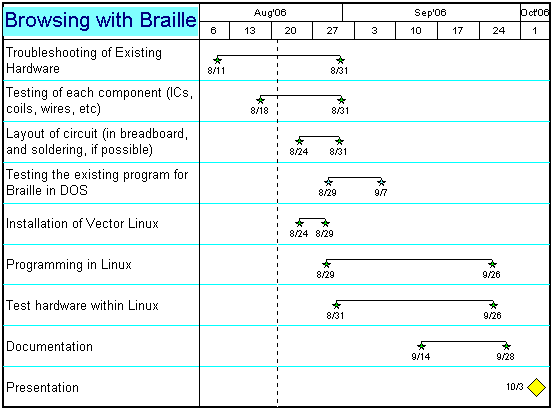 The disabled are oftentimes left behind in the development of technological
applications. The focus for this project is to provide the blind with the
capability to write and edit files using inexpensive personal
computers and open-source software. In this way, the blind
could become productive, enhance his or her feeling of self worth, and
eventually assume leadership roles in the community.
The disabled are oftentimes left behind in the development of technological
applications. The focus for this project is to provide the blind with the
capability to write and edit files using inexpensive personal
computers and open-source software. In this way, the blind
could become productive, enhance his or her feeling of self worth, and
eventually assume leadership roles in the community.
The braille system reads the text displayed on the monitor and presents
the characters to the blind using a specially designed dynamic braille
display for the blind's fingers to scan. Indicators are provided so that
the position of the characters with respect to the whole file is given
for the blind's fingers to scan. The dynamic braille display takes
the place of the monitor. As with the non-blind, the keyboard is also the
way that the blind communicates with the computer for instructions, editing
and saving, and navigation within the computer. Access to the internet will
be provided by text-based browsers within the Linux operating system.
The project is constructed such that associations for the blind could avail
of x486 and lower pentium computers to open new corridors for the blind.
|
|
Room Monitoring System
by Anna Veronica Baterina, Jeric Macalintal, and Beverly Marquez
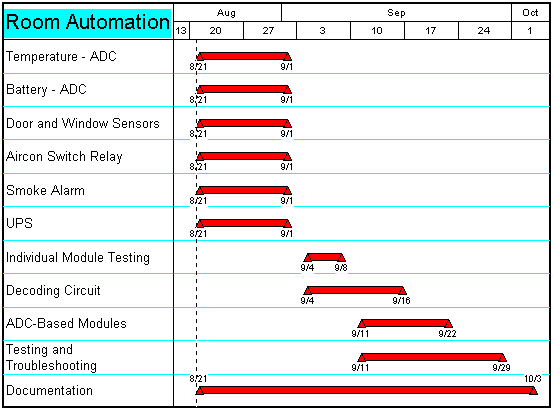 A longtime fad of dreamers and self-proclaimed oracles for the twenty-first
century has been the advent of a computer controlled home, where the user
exerts minimal effort to make sure their surroundings are comfortable, safe
and convenient. In this project, control and automation of a room's
functionality are centralized through a single terminal and several buses. All
functions are carried out by electronic devices whose roles are maintained by
a single in-room terminal. Such functions include feedback for vital project,
a room's functionality, determined by the needs for temperature control and
safety, applies temperature monitoring, air-conditioner switching control,
feedback and timer, back-up battery monitoring, one intruder alarm, and a smoke
alarm.
A longtime fad of dreamers and self-proclaimed oracles for the twenty-first
century has been the advent of a computer controlled home, where the user
exerts minimal effort to make sure their surroundings are comfortable, safe
and convenient. In this project, control and automation of a room's
functionality are centralized through a single terminal and several buses. All
functions are carried out by electronic devices whose roles are maintained by
a single in-room terminal. Such functions include feedback for vital project,
a room's functionality, determined by the needs for temperature control and
safety, applies temperature monitoring, air-conditioner switching control,
feedback and timer, back-up battery monitoring, one intruder alarm, and a smoke
alarm.
|
|
PC-based Controller for Acoustic Laser (SASER)
by Edgie Guevarra, Jr and Fatima Medina
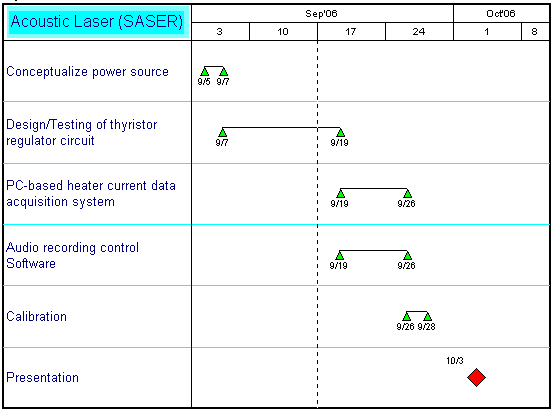 In the acoustic laser (SASER), clean high power sound is produced.
In the acoustic laser (SASER), clean high power sound is produced.
This project provides controlled current to the SASER's heating filament,
digitizes the current values, and stores them in the database. It also
records the sound produced by the SASER device.
The data gathered by the project will be analyze by other research groups.
|
|
Automated Newtonian Telescope
by Carlos Ezequiel, Rogelio Naval, Jr and Jerwin Uy
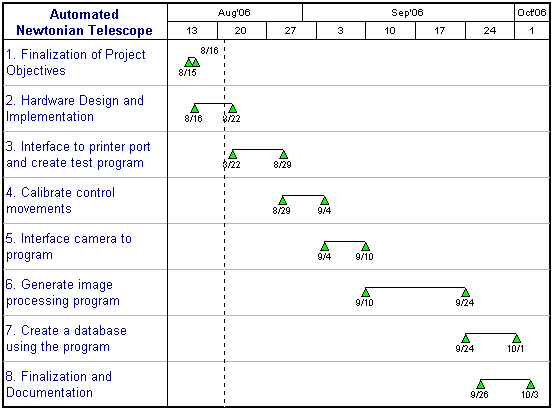 We want to design an Automated Newtonian Telescope for tracking celestial
bodies. It will be a low-cost alternative to the commercial Newtonian
Telescopes, whose prices range from $134 to $4400. The telescope will
have an altitude-azimuth mount, controlled by two stepper-motors. It will
be equipped with a web camera and interfaced with a control circuit that
connects to the parallel port of a personal computer. Movements will be
controlled by a software program.
We want to design an Automated Newtonian Telescope for tracking celestial
bodies. It will be a low-cost alternative to the commercial Newtonian
Telescopes, whose prices range from $134 to $4400. The telescope will
have an altitude-azimuth mount, controlled by two stepper-motors. It will
be equipped with a web camera and interfaced with a control circuit that
connects to the parallel port of a personal computer. Movements will be
controlled by a software program.
We will limit the study to simple image processing algorithms. The
quality of the image taken by the program will depend on the resolution
of the web camera. We will design a database that stores images of
celestial bodies, including the spatial coordinates, time and date of
capture.
|
|
Remote ECG with Stethoscope to Save Lives
by Jovilyn Fajardo and Rowena Predas
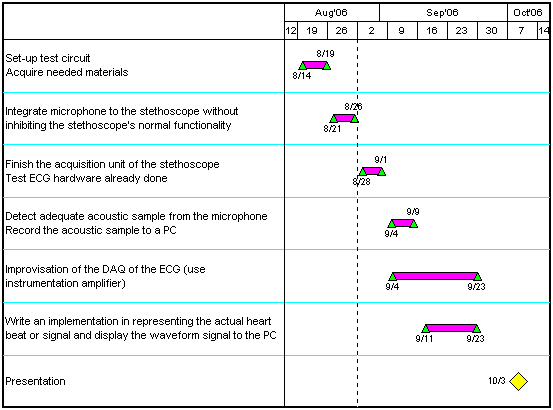 Specialized cardiac centers are few and not easily accessible to
everyone. Many patients are lost while enroute to these centers.
Still many more simply pass away because they are a considerable
distance (or time) away from these centers.
Specialized cardiac centers are few and not easily accessible to
everyone. Many patients are lost while enroute to these centers.
Still many more simply pass away because they are a considerable
distance (or time) away from these centers.
The main purpose of this project, therefore, is to make use of
technology to bring cardiac patients as close as about FIVE minutes
away from cardiac specialists, wherever in the world they happen to
be.
The system is provided with a digital stethoscope that gives the
specialist a further insight into the other processes of the
patient.
|
|
HV Wave-Form Control for Artificial Muscles
by Fatima de Lara and Ma Theresa Joy Rocamora
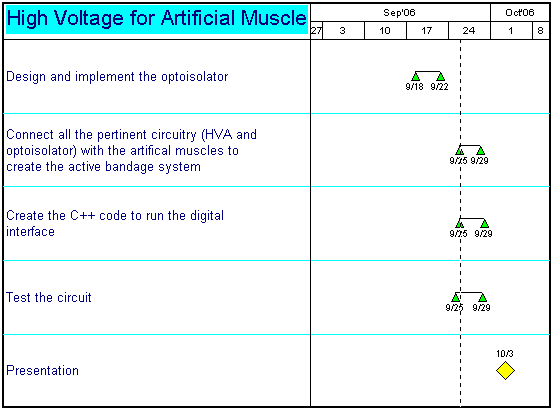 This study explores the application of the properties of
polymers, specifically its use as an active bandage in the
biomedical field. Applying high voltage across its surface causes
the polymer to contract and expand, hence its viability as an
electrostrictive actuator. Once the active bandage is available in
the market, the voltage must be supplied at a regular interval in
order to mimic the natural movement of human muscles.
This study explores the application of the properties of
polymers, specifically its use as an active bandage in the
biomedical field. Applying high voltage across its surface causes
the polymer to contract and expand, hence its viability as an
electrostrictive actuator. Once the active bandage is available in
the market, the voltage must be supplied at a regular interval in
order to mimic the natural movement of human muscles.
This can be accomplished by creating a digital interface that
would replace the mechanical high voltage amplifier. The digital
interface is composed of an opto-isolator circuit and the high
voltage amplifier. A computer program controls the amount of
voltage that can be sent to the active bandage system.
Additionally, the program also has a system to detect the feedback
voltage from the active bandage system.
|
|
3-D Face Scanner
by Rexmund Soriano, Varsolo Sunio, and Anthony Cris Tiu
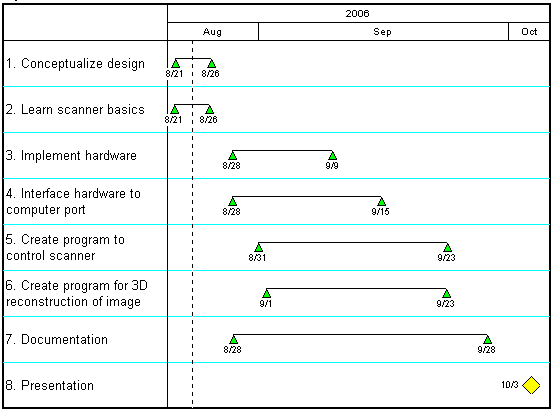 This project makes use of a low-cost scanner to produce images
reconstructed in 3D space. The scanner takes a collection of
images of an object by rotating around it, then displays them as
one complete 3D image. This project is especially useful in
medical imaging as this will enable the doctor to look at the
pictures from any angle, and to zoom in or out a particular
feature in the image.
This project makes use of a low-cost scanner to produce images
reconstructed in 3D space. The scanner takes a collection of
images of an object by rotating around it, then displays them as
one complete 3D image. This project is especially useful in
medical imaging as this will enable the doctor to look at the
pictures from any angle, and to zoom in or out a particular
feature in the image.
|
|
Acoustic Rain Gauge
by Maris Alano, Vernice Casareno, and Rachelle de la Rama
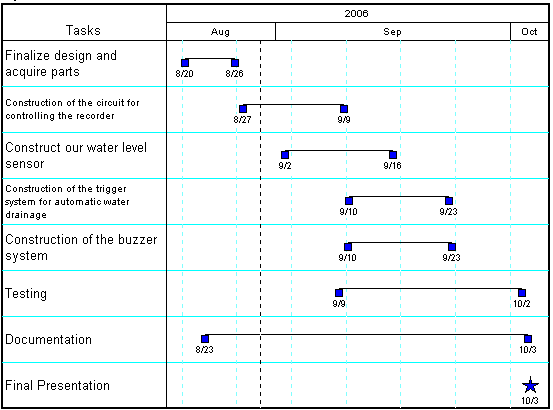 This project will focus on design and fabrication of an
acoustic rain gauge system. Our system will be able to control
a Sony recorder using a computer. To calibrate the rain gauge,
we will use an automated tipping bucket. For the tipping bucket,
we will use an infrared water level sensor to detect if the
water level reaches the draining point. When the water is being
drained, a buzzer will sound that will be heard by the
recorder.
This project will focus on design and fabrication of an
acoustic rain gauge system. Our system will be able to control
a Sony recorder using a computer. To calibrate the rain gauge,
we will use an automated tipping bucket. For the tipping bucket,
we will use an infrared water level sensor to detect if the
water level reaches the draining point. When the water is being
drained, a buzzer will sound that will be heard by the
recorder.
|
|
|

